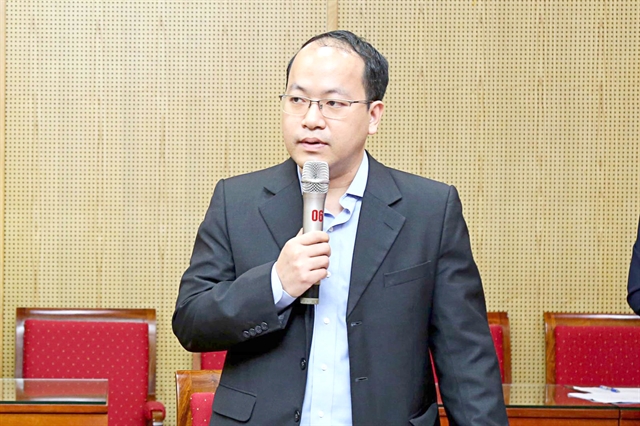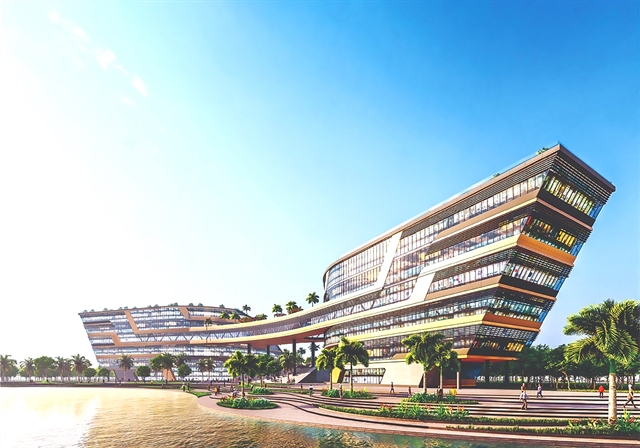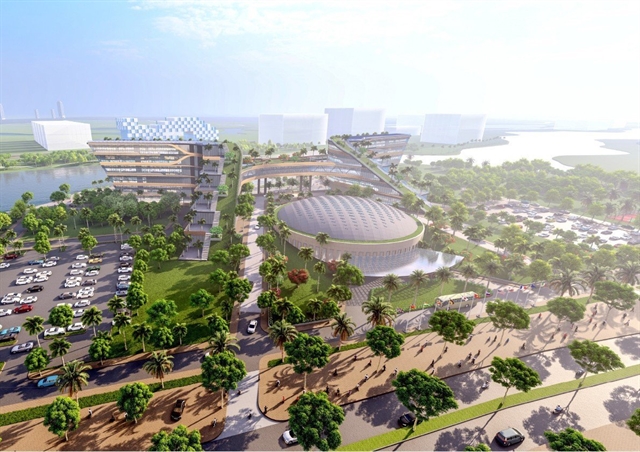 Society
Society


|
| Vũ Quốc Huy, director of the National Innovation Centre (under the Ministry of Planning and Investment). — Photo mpi.gov.vn |
Director of the National Innovation Centre (NIC) Vũ Quốc Huy speaks to Tổ Quốc (Homeland) e-newspaper on the centre's new facilities in Hòa Lạc Hi-tech Park and its role in promoting innovation.
What are the purposes and functions of the NIC in Hòa Lạc Hi-tech Park?
The NIC in Hòa Lạc Hi-tech Park was built in early 2020, the second facility of the centre. After nearly three years of construction with support from multiple partners, the new facility will be inaugurated in late October 2030 with a total area of 4.96 hectares, of which the total floor area for working is nearly 20,000 square metres.
The centre consists of two six-storey buildings and an international convention centre for global conferences and exhibitions.
We built the place with the aim of developing the innovation ecosystem at the grassroots level of the centre with all the factors, including research institutes - universities, businesses, big tech corporations, capital funds, incubators for innovation, small and medium-sized enterprises (SMEs) and start-ups.
Particularly, we have reserved a space for businesses and partners to come here to work and set up their research and development facilities, or representative offices in the case of major global tech corporations. We also expect to build labs and research rooms for key areas of the NIC, especially a chip design incubation centre with advanced technology from Synopsys.
For the event building with a capacity of around 1,500 seats, we plan to host regular seminars, performances and technology product showcases.
As the establishment goes into operation, NIC in Hòa Lạc is expected to attract a large number of partners in innovation to work here and form a complete ecosystem of national innovation.
Why was Hòa Lạc chosen as the location for NIC’s facilities and how will the centre’s infrastructure and technology resources respond to the requirements of a hi-tech park?
The first reason is that this is one of Việt Nam’s three hi-tech parks where science and technology companies across the country gather.
This is also an area with quite many research institutes and major universities such as Vietnam National University - Hanoi and FPT University, as well as several big tech companies of Việt Nam, for example, Viettel and FPT. These are important factors in forming connections and an innovation ecosystem.
Hòa Lạc Hi-tech Park is also suitable for science-technology development and innovation, with the combination of research and development centres and working space for experts.
Another reason is that businesses and partners working here and participating in the NIC’s innovation ecosystem can benefit from preferential policies regarding taxes, land and visas.
The highlights that differentiate the NIC from others include the centre being the only national facility that implements the government’s directions and policies in promoting innovation.
The NIC also has its own set of special policies. A notable one among them is Decree No 94/2020/NĐ-CP specifying the preferential policies for the NIC issued by the government in 2020.
The centre also has a network of major partners in the country and abroad and in the ecosystem. Individuals, organisations and partners participating in this network will see many benefits and chances to connect with other stakeholders in the national innovation ecosystem.
For example, businesses in the centre’s innovation ecosystem will have the opportunity to connect with capital funds and other companies to expand their markets and improve investment capacity. Particularly, start-ups will receive significant support from collaboration programmes between the local, international partners and the centre, such as ADB Ventures, Vietnam Venture Summit, Vietnam Innovation Challenge and Google for Start-ups, among others.
In addition to this, NIC facilities also have co-working spaces such as labs and research centres. These are spaces that innovation start-ups, businesses, individuals and organisations working in the centre can utilise, thereby improving their efficiency and contributing to the common operations of the innovation ecosystem.

|
| A rendered image of the National Innovation Centre's new facilities. — Photo courtesy of the National Innovation Centre |
Regarding transportation between the inner city and the hi-tech park, what are NIC’s plans to attract human resources to come and work here based on past experiences of other organisations based in the area?
The highlights that I mentioned earlier are expected to attract experts and businesses to Hòa Lạc Hi-tech Park.
Transportation between the inner city and the Hòa Lạc Hi-tech Park is now quite convenient. We are also developing an accommodation and services complex for experts in the area around the NIC in Hòa Lạc to create the best conditions for them at work.
A recent World Bank survey shows that most Vietnamese start-ups apply digital and technology solutions because there is less requirement for basic or in-depth research, which is the opposite of the case of manufacturing. Is this an issue that needs more attention?
First and foremost, Industrial Revolution 4.0 has posed numerous challenges to Vietnamese businesses in applying technology.
Digital and information technology is one of the key areas. I believe that the more companies in Việt Nam can utilise digital technology advancements in their operations, the better it will be for their business and production efficiency.
Therefore, we don’t see a conflict between the increasing adoption of digital technology and promoting their engagement in other key areas.
The NIC’s eight areas of priority are smart factory, smart city, hydrogen technology, semiconductor industry, environmental technology, medical technology, digital communications and cyber security.
The NIC will have focused measures to support innovation start-ups, businesses and partners to grow in these eight key areas. These are also the fields expected to create breakthroughs and new driving forces for Việt Nam’s socio-economic growth, contributing to the development goals in the country’s socio-economic development strategies in the 2021-2030 period.
In fact, the NIC is currently working with many cooperation programmes with global organisations as well as local and international companies on support programmes in accordance with the centre’s key areas of focus.
Why did the NIC choose these eight areas as priorities for support and development?
As I mentioned, these are the eight areas aligning with global development trends and the fourth industrial revolution.
These eight priorities also follow the Politburo’s direction on active engagement in Industrial Revolution 4.0 for breakthroughs and new momentum for the 2021-2030 socio-economic development goals.
The NIC’s areas of focus are also prioritised by the government and need preferential policies for growth. Most of them are included in the list of technology and high-tech products prioritised for development approved by the Prime Minister.

|
| The complex spans a total area of 4.96 hectares in Hòa Lạc Hi-tech Park on the outskirts of Hà Nội. — Photo courtesy of the National Innovation Centre |
What are the challenges for Việt Nam’s innovation progress and how will NIC help businesses overcome those?
The government and ministries, sectors have paid great attention with determined decisions to promoting innovation and start-ups, especially in regard to new policies that support businesses in digital transformation and implementing innovation solutions.
However, there are challenges to address for progress and the development of the innovation workforce.
From our observations, some of the challenges to be resolved include those related to policies and frameworks.
Currently, the innovation policies are present in legal documents such as investment law, law on the support for SMEs, Decree No 94 and the support policies for the NIC.
However, we need to address the policy bottlenecks in mobilising venture capital and community funding for innovation, especially in regard to the investment environment and the legal framework for venture capital funds in Việt Nam. This is to encourage capital flow from these funds to innovation start-up projects and businesses, facilitating their timely access to the diverse capital sources in the country and abroad to implement their business and investment ideas.
We also need to further develop organisations and centres that support innovation activities. In addition to the NIC, businesses and localities need to pay attention to and focus on innovation to create a movement and spread the spirit of innovation.
Another aspect for improvement is the development of human resources for innovation and for the key areas of priority.
The NIC has been deploying multiple human resources development programmes in collaboration with major partners such as Google and Meta.
To improve human resources and enhance the capacity of workers and students in innovation in the near future, it is necessary to promote these activities in prioritised sectors that Việt Nam has yet to have in-depth training such as the semiconductor industry.
Minister of Planning and Investment Nguyễn Chí Dũng said that the commitment of the NIC and capital funds is to invest billions of USD in start-ups. How is the cooperation with major international organisations and implementation plan for this goal?
Start-ups are also the focus of the NIC in the innovation ecosystem. When we design support programmes and projects, it is important to facilitate businesses’ access to capital sources from investment funds and financial institutions, as most start-ups have the ideas but lack the financial resources for implementation.
With that goal, NIC hosts annual activities that connect investment funds with businesses, notably the Vietnam Venture Summit. At this event, capital funds have made strong commitments to accelerate funding for Vietnamese businesses.
We also make public information on the investment and funding for innovation and start-ups on an annual basis.
How will the NIC’s mission contribute to promoting the Vietnamese people’s innovation power?
In regard to developing the human resources for innovation, the centre has implemented numerous programmes and projects. In our collaboration with Google, for example, we have the Google for Start-up programme, as well as another project enhancing skills for students through short courses on the Coursera platform which attracted tens of thousands of Vietnamese students and intellectuals.
We also have human resources development and exchange programmes for students, with a special focus on prioritised regions for the matter such as the Cửu Long (Mekong) Delta. — VNS




